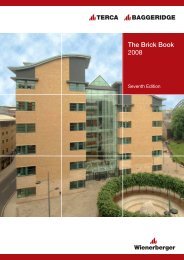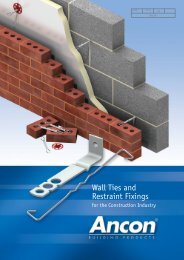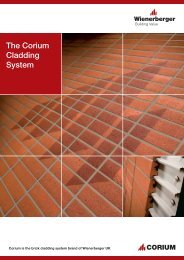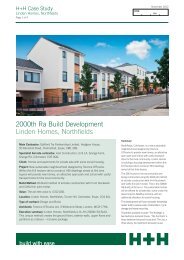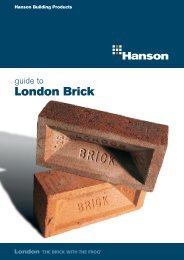Thermal Performance: Part L1A - Masonryfirst.com
Thermal Performance: Part L1A - Masonryfirst.com
Thermal Performance: Part L1A - Masonryfirst.com
Create successful ePaper yourself
Turn your PDF publications into a flip-book with our unique Google optimized e-Paper software.
<strong>Thermal</strong> <strong>Performance</strong>: <strong>Part</strong> <strong>L1A</strong>Services optionsconsidered in the studyGas boilerA condensing, <strong>com</strong>bination boiler was specified for the smallerdwellings and a regular boiler for the larger dwellings unless theyincluded a flue gas heat recovery system, in which case they had a<strong>com</strong>bination boiler (see ‘Flue gas heat recovery’).As an alternative to gas boilers, air source heat pumps were alsoconsidered, but ultimately not included in the study for two key reasons:1. They have a relatively high capital cost, whilst generally achievingonly a small reduction in heating bills <strong>com</strong>pared to a boiler onmains gas.2. CO 2 savings are likely but not guaranteed and can be quite modest.On balance, it seems likely at the present time that condensing gasboilers will remain the preferred option on sites where mains gas isavailable. Where this is not the case, heat pumps are likely to offer a moreeffective option.Waste water heat recovery (WWHR)Whilst relatively new in the UK, waste water heat recovery systemsare already widely used in the Netherlands. They work by recoveringheat from the shower waste with a simple heat exchanger, and usingit to pre-heat the cold water supply to the shower mixer tap and, insome systems, the cold water supply to the hot water cylinder or<strong>com</strong>bination boiler. A typical installation can save energy equivalent toa 2m 2 installation of solar thermal hot water [5] and therefore make asignificant contribution to reducing emissions.Two systems are currently available; one incorporates a heat exchangerwithin the shower tray, which provides an efficiency of around 47%,whilst the other uses a vertical heat exchanger which wraps aroundthe waste pipe, giving an efficiency of around 60% [6] (and was usedin the study). Both options are included in Appendix Q of SAP. Wasteheat from bath water cannot be recovered as the bath is not filled atthe same time as the grey water disposal. However, it can work where ashower is located over the bath. In addition to the two WWHR productsmentioned, alternative products are anticipated in the near future.Weather <strong>com</strong>pensatorThis is a device that monitors outside temperature and uses it todetermine how warm the water in the heating system needs to be tomaintain the dwelling at the required temperature. By optimising theflow temperature (i.e. keeping it as low as possible), the boiler worksin condensing mode for longer, maximising its efficiency and savingfuel. Most of the large boiler manufacturers can provide a weather<strong>com</strong>pensator as an option. It is particularly effective in dwellings wherethe energy required for space heating makes up a significant part of theoverall energy consumption e.g. detached homes.Hot water cylinder insulationAs dwellings have be<strong>com</strong>e better insulated, the relative significance of CO 2emissions from domestic hot water has grown. So, increasing the foaminsulation on hot water cylinders from around 50mm to 80mm or morecan be a cost effective way of reducing emissions. To put this into context,it is roughly equivalent to the saving achieved by moving the external wallU-value from 0.18 to 0.15 W/m 2 K in an end terrace house. Viewed anotherway, it might also enable the use of a full fill cavity wall instead of a moreexpensive partial fill cavity, without increasing overall emissions.A waste water heat recovery unit, designed to be located below a shower tray.Courtesy of AK Industries Ltd.Flue gas heat recovery (FGHR)As the name suggests, flue gas heat recovery systems extract waste heatfrom the boiler flue and use this to reduce the fuel needed to producehot water. The way in which this is achieved depends on the system usedbut they generally feature a heat exchanger mounted directly above theboiler, through which the flue gases pass and heat is recovered.The smaller dwellings in the study featured a simple FGHR system whichpreheats the in<strong>com</strong>ing mains water supply to the <strong>com</strong>bination boiler,improving both its efficiency and flow rate.In larger dwellings, a slightly more sophisticated system was used,featuring a separate hot water store providing additional preheatingof the mains water supply to the boiler. This enables a heavy hot waterdemand to be satisfied for long periods whilst maintaining a highflow rate; something a <strong>com</strong>bination boiler alone would not ordinarilybe able to achieve in larger dwellings. So, in addition to enabling heatrecovery from flue gases, it makes <strong>com</strong>bination boilers a more practicalproposition in larger properties.6



